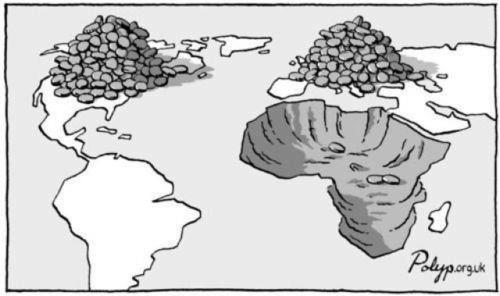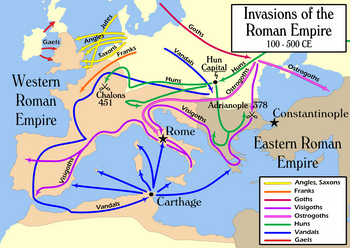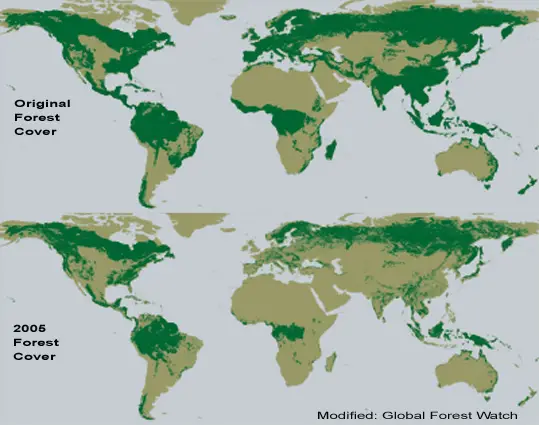from Part 7 - Kenneth Boulding said belief in indefinite "growth" is the mark of madness or economics. He also said that "dissipative structures allow complex systems to achieve and maintain a high level of order by dissipating their entropic tendencies, i.e. their tendencies to disorder, disorganization, and energy loss, to neighboring systems."
This is essential for understanding how entropy in capitalism translates into the division of the social world.
"Neighboring systems," using Boulding's term, ought to remind us of what the Gospels say about neighbors. What Boulding means, apart from what the Christian obligation is to the neighbor (love!), is that certain regions and-or states are literally built-up using materials and energy that are extracted from other regions and-or states. The increase in order with the build up of new technomass in these "cores" results in increased disorder and scarcity in those exploited "peripheries." These terms are borrowed from a school of thought called "world systems theory."
World systems theorists who have studied global capitalism from a thermodynamic perspective have concluded that, in many respects, this thing called "development" is a zero-sum game which is dressed up as a cornucopia. The propaganda for development, even from the former socialist bloc, was guilty - according to this analysis - of embracing a radical technological optimism - the belief that no matter what resources we use up (dissipate), out inventiveness will continually move us along to some new technological fix.
Based on the zero-sum perspective (which I share), development cannot "advance," i.e., increase technological complexity, except at the expense of some other area, for all the reasons discussed in the preceding installment of this series. It is this dynamic, of technomass and resulting disorder, in which disorder will always (according to the law of entropy in the thermodynamic case) exceed the order created by technomass, that result directly in social relations marked by profound inequality and domination of the periphery by the core.
This was even true in Imperial Rome, where the demands of the city-state core led to the exhaustion of agricultural lands, first near Rome, then successively further and further away, which accelerated the need for greater imperial expansion into more peripheries to ensure political stability in the Roman core.
This correspondence between the physical world (and dissipative processes) and social domination and disorder still holds true today.
Robert Biel writes:
[W]hatever peripheral areas... may be admitted into the club of developed countries (if we accept at face value the most optimistic assumptions of mainstream development discourses), their contribution is surely outweighed by the increase of exclusion within their own borders, and indeed within those of the historic core. (from his essay, "The Interplay Between Social and Environmental Degradation in the Development of the International Political Economy")
Here is an abstract from a report on critical materials from the Rand Corporation - which has an ongoing contract with US Government agencies, including the Central Intelligence Agency:
The United States economy, and especially its manufacturing sector, is dependent on the supply of raw and semi-finished materials used to make products. While the United States has extensive mineral resources and is a leading global materials producer, a high percentage of many materials critical to U.S. manufacturing are imported, sometimes from a country that has the dominant share of a material's global production and export. This report specifically identifies 14 critical materials for which production is concentrated in countries with weak governance, as indicated by the World Governance Indicators published by the World Bank. China is the controlling producer of 11 of these critical raw materials, nine of which have been identified as having high economic importance and high supply risk. As its market share and domestic consumption of critical materials has grown, China has instituted production controls, export restrictions, mine closings, and company consolidations that have led to two-tier pricing, which creates pressure to move manufacturing to China and contributes to strong price increases for these materials on the world market. To mitigate the impact of these market distortions on the global manufacturing sector, this report suggests the need for actions that (1) increase resiliency to supply disruptions or market distortions and (2) provide early warning of developing problems concerning the concentration of production.
Once again, we can see how capitalism cannot thrive as a stable system without three guarantees: a steady supply of materials, a market big enough to absorb production and thereby generate profit, and externalization adequate to ensure the bottom line. And we can see that the capitalist nation-state is continually preoccupied with delivering on these guarantees.
Because of the contradictory relationship between return-on-monetary-investment and neg-entropy (exergy), further capitalist development constantly increases socio-environmental degradation (dissipation), which demands newly exploitable peripheries for continued accumulation (the euphemism for which is "growth") by the dominant capitalist group (operating as a core).
What has happened over the past 100 years or so is that industrial methods and the enclosures necessary to facilitate industrial take-off have displaced increasing numbers of people from the country to the city. With increased (and ultimately unsustainable) agricultural production, population has increased (Jevon's paradox) exponentially, with an increasingly money-dependent urban population creating greater demand for basic goods that are on the open market as commodities. The exponential increase in demand has exponentially increased the rate of production (dissipative processes), which is now undermining the very material basis for capitalism as we know it. Marx's prediction that capitalism would be overthrown by organized industrial laborers has failed to materialize; but it looks more and more like capitalism will literally run out of gas... and in the not-too-distant future. This process is already entrained, and it is, especially in the peripheries (and semi-peripheries, as some have theorized), already catastrophic. Moreover, as actual inputs become more dear, the population of the core's dominant groups will shrink, and more and more of us will be consigned to the peripheries (internal and external).
The fraction of insiders will shrink along with the relative loss of exergy (and whatever you wish to call its social correspondent), pushing more and more people - on the whole - into the periphery, and finally into surplus and disposable populations (the landfill). When these limitations are met in the geographic-political peripheries, exclusion will be expanded within the core societies to ensure continued accumulation.
This, in effect, is what is happening in Europe, Australia, and the United States now, the euphemism for which is "austerity."
This process cannot be interrupted or reversed through policies enacted within a capitalist regime without destroying the very basis of capitalism; and this process is inevitable within capitalism because - unlike human laws - no one can break the laws of physics. i.e., the Second Law. What are the actual ways, however, in which the dissipative processes that inhere in industrial-financial capitalism interact with actual societies around the world, particularly in an age when we have seen the economy "globalized"?
To begin to understand this, again, we have to look at history in the light of the stories we hear about the capitalist process. When we limit our account to money (M) is invested in machinery and labor (capital, or C) in order to achieve a return of more money (M+), or if we begin with a financial formula - Money (M) is lent at Interest (I) to achieve a return of more money (M+), or even if we combine the industrial and financial processes described thus, we have conceptually externalized (disappeared) the dissipative processes on nature and society. In particular, we have concealed from view the histories of plunder (by war and conquest), strip-mining nature, and exploiting labor that were necessary before the MCM+ and MIM+ processes could be initiated; and they are necessary to sustain capitalist accumulation.
There are several ways in which "unequal exchange" can happen: force, where something is taken violently with nothing given in return (Aztec gold, African slaves, etc.); mercantile exchange, or buying cheap and selling dear; interest on credit extended during emergency that leads to dependency; labor under-compensation - slave labor or wage labor that pays far less than what is added to products in value by that labor; unequal flow of resources between regions. It is this last one that we'll look at now.
In Haiti, most people lack electricity, automobiles, flush toilets, or manufactured consumer goods beyond a few dishes and containers and some cheap soaps. The cost of social reproduction, that is, the cost of maintaining the lives of the people in that society, is comparatively low. In the United States, the average person is sustained by a steady flow of electricity, gas, petroleum, manufactured goods, automobiles, etc. Look at what you use today, and what you need just to go to work. The cost of our social reproduction is comparatively high.
The average annual income in the United States is around $42,000 a year; the average annual wage in Haiti is around $800 a year. More telling is that the average per capita annual energy consumption in the US is in excess of 300 gigajoules; and the average in Haiti is less than 10 gigajoules.
Because of land enclosures in Haiti to industrially produce sugar (under US military occupation, for a US company - HASCO), the city population exploded, leaving large numbers of people living in shacks, who had become dependent upon money. The Haitian government feared social unrest; the Haitian elites wanted to make money; American manufacturers wanted tax-vacations and cheap labor. One example, General Electric, opened electronics assembly plants in Haiti, where they were allowed by the government and the Haitian elite - for a cut - to operate tax free, and to employ urban Haitians, who could live - just barely - on $3 a day. The lower cost of reproduction allowed GE to pay its employees $3 for an eight-hour day (and GE fought raising the minimum wage to $5 a day). The difference between what GE paid Haitians and what it would have had to pay Americans (who would need at least $50 a day to barely survive) was additional profit.
Between these two regions there was an unequal exchange of both labor and (untaxed) land, and GE was able to dispose of its industrial wastes without environmental regulations. This dynamic between a "core" in the United States and a "periphery" in Port-au-Prince is a "core-periphery dynamic." Areas with a highly industrialized economy and a comparatively high cost of social reproduction are cores; and areas with low industrialization (in terms of consumption) and low costs of social reproduction are peripheries.
There are three essential ways they can be exploited (given the wrong end of the stick during unequal exchange): embodied labor time, embodied land, and embodied productive (thermodynamic) potential. By embodied, I mean a shirt made in a factory embodies a certain average amount of labor time to have made it; it required a certain average amount of land to produce the resources from which it was made; and it transformed a certain average amount of low-entropy into high-entropy by using up particular forms of energy.
If the shirt is made in Haiti, using an average of 15 minutes of labor paid by 10 cents, and the shirt is sold by US company members averaging $5 in pay for the same 15 minutes, to a consumer who averages $3 every 15 minutes, there is an unequal exchange of labor time.
If the sellers and buyers consume the product of one hectare of land with the purchase of a shirt, and the worker consumes the product of 1/100 of a hectare of land in the process of making it, then there is an unequal exchange of embodied land.
If the Haitian who makes the shirt consumes less than 10 gigajoules a years of low-entropy fuel to survive, and the sellers and buyers average 300 gigajoules of energy consumed per year, there is an unequal exchange of energy, or productive capacity.
These three forms of inequality are related, interactive, and mutually-supporting. In the case of labor and land, this inequality is what Hornborg calls the appropriation of time and space.
This unequal exchange in all its forms constitutes the core-periphery relationship; and moreover, in addition to cores extracting advantages from resource flows (importing order) from periphery to core, cores export their waste and their externalized problems (exporting disorder) back into the peripheries. The shirts arrive washed and packaged in the United States, where a consumer can wear one in an air-conditioned building. The factory trash and toxic wastes remain in Haiti, along with the scourge of peripheral urban poverty - which maintains a low cost of social reproduction, reproducing the advantage to the manufacturer of producing in Haiti and selling in the US.
That is not how Jesus tells us to treat our neighbor.
The maintenance and regulation of any system necessarily comes at the expense of dissipating disorder into a surrounding system. Capitalism seems to contain mechanisms which cause it to 'overdevelop,' and hence to generate an excessive amount of disorder which must be absorbed somewhere... [T]his takes two forms. One the one hand, human society has a physical environment, the ecosystem. Its relationship with this environment should be... handled in a sustainable way. But since the capitalist mode of production has taken hold of society, it has subordinated this relationship to its own demands and is developing in a way which clearly undermines the integrity of this surrounding system. Secondly, looking within society... this always presupposes a division into one area which appropriates the benefits of order, and another which pays the price. (Biel)*****











This comment has been removed by the author.
ReplyDelete